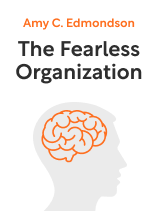

This article is an excerpt from the Shortform book guide to "The Fearless Organization" by Amy C. Edmondson. Shortform has the world's best summaries and analyses of books you should be reading.
Like this article? Sign up for a free trial here.
What is the book The Fearless Organization by Amy C. Edmondson about? What are the main takeaways of the book?
In The Fearless Organization, Edmondson examines what psychological safety is and why it’s important at work. She also demonstrates the detrimental effects of fear-driven work cultures and ways leaders can cultivate psychologically safe environments.
Read below for a brief overview of The Fearless Organization book.
The Fearless Organization by Amy C. Edmondson
In her book The Fearless Organization, Amy C. Edmondson argues that for organizations to thrive in the complex knowledge economy, leaders must cultivate psychologically safe cultures where workers can ask questions, raise concerns, and make mistakes without fear of reprisal. But many companies rely on a fear-driven management approach that silences workers’ voices. They do so at their peril, stifling innovation and putting themselves in harm’s way.
Edmondson is the Novartis Professor of Leadership and Management at the Harvard Business School. She stumbled upon the concept of psychological safety while studying the relationship between teamwork and error rates in hospitals during graduate school. Upon discovering that the strongest teams reported the most mistakes, she realized that these groups openly discussed failure without fear of repercussions, which allowed them to prevent problems and take risks that fostered innovation.
This article is broken into three parts:
- In Part 1, we examine the concept of psychological safety in the workplace, including what it is, why it’s important, and research that backs its efficacy. We also describe the detrimental effects of fear-based workplaces.
- In Part 2, we talk about ways that leaders can build and foster psychologically safe environments at work to drive innovation and success.
- In Part 3, we offer final thoughts on ways that nonleaders can create psychologically safe spaces in the workplace and beyond.
Part 1: The Concept of Psychological Safety
In this first section, we’ll explain what psychological safety in the workplace is, describe why it matters, and examine research supporting its benefits for employees and companies.
Edmondson says that psychologically safe workplaces encourage workers to ask questions, share concerns, and risk failure without fear of being judged or experiencing reprisal. She says that psychological safety bolsters factors that drive organizational success including talent, ingenuity, and diverse ideas. When combined with a strong organizational strategy to achieve goals and a motivated, well-trained workforce, psychological safety enables workers and companies to thrive in a sustainable way.
When workers feel safe to speak up and make mistakes, they can:
- Learn and grow, tap into their creativity, and innovate at their fullest potential
- Ward off avoidable problems by telling their organization about flawed workplace practices and conditions
- Support growth by sharing observations about the market—a critical benefit in an increasingly complex working world defined by the quality, quantity, and accessibility of ideas
Part 2: Practices to Help Leaders Create a Psychologically Safe Workplace
We’ve covered the detrimental effects of fear-driven work cultures. Next, we’ll examine key practices leaders can employ to build sustainable, psychologically safe workplaces.
Practice 1: Reshape and Redefine Company Belief Systems
Edmondson says building psychologically safe cultures begins with reshaping and redefining broadly understood, often long-held, sometimes deeply entrenched belief systems within organizations. It can be an arduous process that requires patience, particularly in companies where psychological safety hasn’t previously existed. Leaders have to work in consultation and collaboration with employees and other stakeholders to build trust—particularly with employees who have come to learn that engaging and speaking up will lead to repercussions, even when encouraged to do it.
Practice 2: Redefine Failure
Redefining the purpose and value of failure can help employees view mistakes that they and others make not as problems to avoid at all costs and sweep under the rug, but as opportunities to improve their work and support their company in achieving its goals. Leaders can encourage employees to identify, address, and speak openly about mistakes and failure by redefining failure in the following ways:
1) Failure is a natural and valuable part of the learning process so long as you identify and analyze it after the fact to understand why things didn’t work, where they went wrong, and ways you can prevent the same problem from happening again.
2) Failure is a required part of experimental, investigatory, and exploratory processes that allow you to quickly move forward and figure out what solution works best.
3) Failure is a warning sign that can avert preventable problems and disasters.
Practice 3: Encourage Employees to Speak Up
Edmondson says that leaders must create a safe space for employees to ask questions, engage in debate, and learn from one another. Building psychologically safe work cultures enables workers to tap into their creativity and innovate, which in turn improves their engagement and performance.
As a leader, you can encourage employees to speak up by modeling curiosity and humility, asking thoughtful questions, and putting structures in place that support your efforts to engage employees. This will bring workers into the fold, inspire them to replicate behavior you want to embed in your organizational culture, and foster employees’ belief that what they have to say is important.
Part 3: Building Safety From the Bottom Up
You’ve learned how leaders can cultivate psychologically safe work cultures, but what if you’re an employee and don’t have the power to change the climate of your organization from the top down?
Edmondson says that even if you’re not the boss, you can be a leader by creating psychologically safe spaces for your coworkers by:
- Asking colleagues questions from a place of curiosity and actively listening to their responses. Asking coworkers about challenges they face or ways you can help them lets them know that they can share ideas and concerns—and be themselves—with you.
- Showing your vulnerability when you make mistakes or don’t know something, apologizing when you’re wrong, and asking others for help—which permits others to do the same.
- Acknowledging shared challenges or moments of uncertainty that you and your team confront. Recognizing a shared experience where answers are unknown strengthens your bond and communicates that it’s okay not to know everything.
Edmondson also recommends these strategies if you find yourself working with a manager who is unwilling or unable to change. Although you can’t force them (or anyone) to change, you may be able to influence their behavior and buy yourself some goodwill by modeling genuine curiosity about their experience, showing compassion for challenges they face, and demonstrating your dedication to your work.

———End of Preview———
Like what you just read? Read the rest of the world's best book summary and analysis of Amy C. Edmondson's "The Fearless Organization" at Shortform.
Here's what you'll find in our full The Fearless Organization summary:
- The importance of psychological safety in the workplace
- How leaders and non-leaders can foster psychologically safe environments
- Why workers should be able to make mistakes without fear of reprisal






